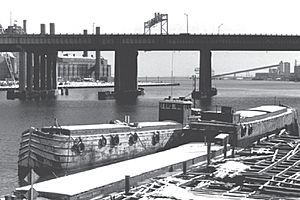Priscilla Dailey facts for kids

1937 photo of the three barges; Priscilla Dailey is in the forefront
|
|
| History | |
|---|---|
| Owner | Steward J. Dailey |
| Operator | S. J. Dailey Company |
| Route | Connecticut–Long Island Sound |
| Builder | William J. Ryan |
| Completed | 1929 |
| Out of service | 1974 |
| Fate | Sunk in 1974 |
| General characteristics | |
| Type | Canal barge |
| Tonnage | 311 |
| Length | 111.1 feet (33.9 m) |
| Beam | 24 feet (7.3 m) |
| Depth of hold | 11.8 feet (3.6 m) |
|
Priscilla Dailey
|
|
| Location | Bridgeport Harbor, Bridgeport, Connecticut |
| Area | less than one acre |
| Built | 1935 |
| Architect | Ryan, William J. |
| NRHP reference No. | 78002837 |
| Added to NRHP | December 21, 1978 |
The Priscilla Dailey is a special wooden barge that was built in 1929. It was first called the Elizabeth E. Newell. This large boat was used to carry heavy goods like sand or gravel. It traveled in the busy harbors of New York, New Jersey, and Connecticut.
In 1974, the Priscilla Dailey sank in the harbor of Bridgeport, Connecticut. It went down with two other barges, the Elmer S. Dailey and the Berkshire No. 7. Today, the sunken boat is very old and fragile. Trying to pull it out of the water might cause it to break apart. Because of its history, the Priscilla Dailey was added to the National Register of Historic Places on December 21, 1978. This means it's an important historical site.
What Does the Priscilla Dailey Look Like?
The Priscilla Dailey is a long boat, measuring about 111 feet (33.8 meters). It is 24 feet (7.3 meters) wide. The part of the boat that holds cargo is about 11.8 feet (3.6 meters) deep. It could carry a lot, up to 311 tons of material.
The boat has a shape that is almost like a rectangle. Its back end is squared off, and the front is gently rounded. There are low walls on the sides that rise a bit at the front. A small cabin is located near the back of the boat. This cabin is the same width and height as the boat's main structure.
When the boat was studied in 1978, some parts were missing. The covers for the hatches (openings to the cargo area) had likely floated away. Also, a square cover over the entrance to the cabin was gone.
The Story of the Priscilla Dailey
The wooden canal boat Priscilla Dailey was built in 1929. It was made by William J. Ryan in Whitehall, New York. The first owner was Anthony O. Boyle. Later, in 1941, Stewart J. Dailey bought the boat. That's when its name changed from Elizabeth E. Newell to Priscilla Dailey.
Even though it was built in the 20th century, its design was more like older canal boats from the 1800s. For many years, from 1941 to 1972, it carried goods in the harbors of New York, New Jersey, and Connecticut. After 1972, it was kept in the harbor of Bridgeport, Connecticut. It was moored there with the Elmer S. Dailey and Berkshire No. 7.
In the spring of 1974, one of these barges started to fill with water. As it sank, it pulled the other two barges down with it. During a neap tide (when the tide is lowest), you can still see about one-third of the Priscilla Dailey's hull above the water. The boat is officially listed in the U.S. Registry as #170368.
Why Is This Barge Important?
The Priscilla Dailey is very important for history. It is one of the few old wooden canal boats that still exist. It helps us understand how goods were transported on canals a long time ago. Its design shows us what 19th-century canal boats looked like, even though it was built much later.
It was added to the National Register of Historic Places in 1978. This was unusual because boats usually need to be at least 50 years old to be listed. The Priscilla Dailey was only 49 years old when it was added, and it had already sunk! The Priscilla Dailey and the two other barges that sank with it are the only shipwrecks in Connecticut listed on the National Register of Historic Places.
Over the years, the sunken barges have become very fragile. If someone tried to pull them out of the water, they would likely break apart. In 2003, a report said that if any work was done near the Priscilla Dailey, it should first be fully documented. This means taking photos and writing a detailed description of the barge. These records would then be kept at the State Historic Preservation Office and the Mystic Seaport Museum. This helps preserve its history even if the boat itself cannot be saved.



